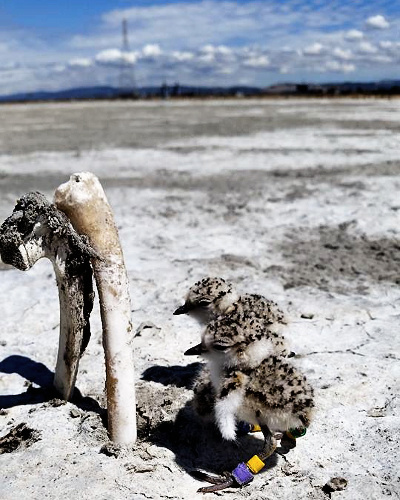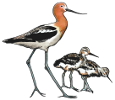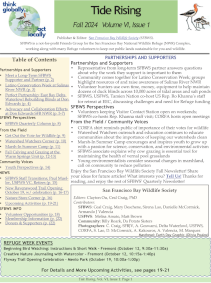Help San Francisco Bay Bird Observatory raise funds for its 'Protect Our Plovers' campaign

Snowy Plover chicks banded at the leg. Credit Sebastian Kennerknecht Photography for San Francisco Bay Bird Observatory.
by Karine Tokatlian, Plover Program Director and 'Protect Our Plovers' campaign organizer for San Francisco Bay Bird Observatory
In 2017, SFBBO will be going into our 14th year of monitoring Western Snowy Plovers in the San Francisco Bay area. But this year is different: we have no funding for research at their most important breeding site, Eden Landing Ecological Reserve. In the current climate of conservation uncertainty, we are turning to you, the scientific and environmental community, for help to continue our research to save these birds from extinction. Our campaign launches today, December 15, 2016. Visit https://www.generosity.com/animal-pet-fundraising/protect-our-plovers to help us raise $25,000. Even if you are unable to donate, sharing this information with friends and family would be greatly appreciated.
With your help, we will:
* Monitor 1,200+ hours of breeding activity at Eden Landing Ecological Reserve
* Protect 150+ nests and chicks from being eaten, flooded, or stepped on
* Advise federal and state agencies who enforce protective laws
* Engage 400+ individuals at public outreach events
* Meet species recovery goals to fight the threat of their extinction

A Western Snowy Plover at the Eden Landing Ecological Reserve. Credit Mike Mammoser for San Francisco Bay Bird Observatory.
Donation Perks!
To thank you for your donation, we offer perks at each donation level. Some are limited so grab them fast! We will still gratefully accept donations on all levels if all perks are claimed.
Donation Levels
$25 Grassroots Level
The loud and local voice for our SF Bay plovers! You'll support our basic operations including daily communication with our coastal constituents, monthly volunteer activities, and managing mountains of data. Perk: a plover sticker from us!
$50 Plover Protector Level
You'll enable our biologists to discourage pesky predators, knock down tall objects where falcons perch to hunt, and work with specialists to control waste and feeding stations. Perk: a plover card from us!
$100 Admirable Advocate Level
You'll fund our Plover Docent Program with materials like signs and pictures to help us connect with 400+ members of the public. You'll also support our Adopt A Nest campaign where you can champion a nest and watch it develop. Perk: one symbolically adopted nest during 2017.
$200 Intrepid Biologist Level
You'll fund 1,200+ hours of biological work, protect 100+ nests from predation and flooding, and equip our biologists with the optics and GPS units needed to do our surveys. You'll also help us determine how well oyster shells improve plover breeding success - a long-term effort that is essential for Restoration Project management. Perk: the opportunity to join our plover biologists for a day of nest monitoring!
$350 Silicon Valley Level
You'll equip our biologists with the technology needed to conserve plovers, including field tablets, the creation of a cloud database, nest cameras, and access to UAS/drones as we study their potential impacts to breeding shorebirds! Perk: Introduction to Drones session with conservation photographer Steve Mandel. Limit is 5 (age 18+)!
$500 Expert Bander Level
You'll enable our biologists to band adult plovers and chicks before they bravely run off into the new world. Perk: the opportunity to join our plover biologists for a day of chick banding! Great for conservationists and photographers. Limit is 10!
$800 Legacy Level
You'll support the long-term goals of our Plover Program including the use of GPS or satellite tags to accurately track plover movement, and quantify nesting density limits to measure how many plovers can be supported by one acre of habitat.
Your donation will help our Plover Program continue our valuable work to save this species.
Thank you truly,
The Plover Program at the San Francisco Bay Bird Observatory
Learn more about us at www.sfbbo.org, www.facebook.com/birdsSF, and @sfbbo.

A plover chick exploring its new world. Credit Sebastian Kennerknecht Photography for San Francisco Bay Bird Observatory.
Our Story
For 13 years, the San Francisco Bay Bird Observatory’s Plover Program has collected scientific data on plovers in the San Francisco Bay. Our biologists have implemented a three-pronged strategy to save the remaining plovers in our Bay.
1. Conduct critical research on the state of the plover population in the Bay by:
* Locating plover nests and tracking their success
* Banding plover chicks to track their movement and survival
* Setting up nest cameras to document predation events and potential harassment
2. Experiment with new techniques to improve remaining plover habitat and increase breeding success by:
* Spreading oyster shells which may provide camouflage for plovers and allow them to avoid detection from predators
* Investigating alternative enhancement materials that may be more effective
* Deterring intelligent predators like ravens using hazing techniques and effigies
3. Provide outreach and information to those who are making critical, "no-going-back" decisions about how we use our last remaining baylands by:
* Deploying Volunteers, Docents, and Outreach teams to engage with the public
* Advising federal and state land managers who have the authority to enforce protective laws and make meaningful regulation
* Collaborating with Restoration Project managers and scientists to find a balance for all struggling species in the Bay
* Advising construction workers by guiding them away from plover nests as they do their work
Good news: our efforts are working! The San Francisco Bay plover population is slowly growing and we've seen that 90% of our community is interested in their recovery.
Bad news: we have zero funding to continue our work in 2017 at their most important site.
Where did our funding go?
In the past, we've received federal and state grants, and contracts to continue our important work. We hope to receive funding from USFWS for federal lands, but we were not re-selected to receive state funding in order to monitor Eden Landing Ecological Reserve, an area where 72% of all plovers breed every year. In this climate of conservation uncertainty we are turning to you, the scientific and environmental community to help us continue our vital research.

Plover chicks are often described as "cotton balls with toothpicks for legs". Credit Sebastian Kennerknecht Photography for San Francisco Bay Bird Observatory.
Testimonials
Western Snowy Plover monitoring in the south bay helps the Refuge to manage appropriate water levels on ponds where nesting birds are present, and evaluate how restoration and enhancement methods are benefiting ... snowy plovers. These data fill in an important data gap for the successful recovery of a threatened species. — Cheryl Strong, Wildlife Biologist, Don Edwards San Francisco Bay National Wildlife Refuge.
The data and expertise SFBBO provides on snowy plovers ... are instrumental to our understanding of the landscape and help shape our management and restoration decisions. — John Bourgeois, Executive Project Manager, South Bay Salt Pond Restoration Project.
Plover Stories
One morning, two breeding seasons ago, I was directed to check on a nest that we had been monitoring closely. The adult female was no where to be seen which was concerning and not normal. When I approached the nest I found 3 partially hatched eggs- cracked enough to see feathers but cold to the touch, and I could hear very faint, weak peeping. The chicks had been abandoned and would not survive so we brought them to be rehabilitated. Several months later I saw the same 3 chicks, now fledglings, foraging in Eden Landing. It was a wonderful feeling to see these birds survive and persevere in the wild because of our rescue efforts. — Emily Moffitt, Veteran Plover Biologist, San Francisco Bay Bird Observatory.
I've worked with this species for 8 years, and if you see them breed, it's not hard to see why. Because they rely on camouflage plovers can seem insignificant but if you watch long enough, they're really quite spunky and charismatic. They look like cotton balls running around on toothpicks and if their legs are banded, they look like they're wearing cowboy boots. Within about 8 hours after hatching, chicks leave the nest and never come back, running and foraging on their own while dad watches from the sidelines for protection and warmth. Plovers deal with every threat you can imagine but seeing tiny chicks facing all of that hardship head-on really speaks to their resilience. They just need a little help from us. — Karine Tokatlian, Plover Program Director, San Francisco Bay Bird Observatory.


